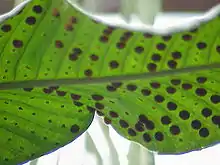Niphidium crassifolium
Niphidium crassifolium, commonly known as the graceful fern, is a species of fern in the family Polypodiaceae found in Central and South America. It is predominantly epiphytic, growing on other plants—for example, in the canopies of trees—but occasionally grows on rocks or on the ground, particularly at higher altitude.[1] It has a rhizome from which many fine rootlets covered in dark reddish-brown scales grow.[3] Together they form a root basket that, when growing on trees, helps to trap leaf litter and dust, forming a nutrient-rich soil that holds water.[4] Its leaves are simple in shape, 13–85 centimetres (5–33 in) long and 3–5 centimetres (1.2–2.0 in) wide and when dry, and covered by a wax-like film. The sori are round and large, occurring in single rows between veins at the far end of the leaf.[3]
| Niphidium crassifolium | |
|---|---|
 | |
| Fertile Niphidium crassifolium cultivated in a greenhouse | |
| Scientific classification | |
| Kingdom: | Plantae |
| Clade: | Tracheophytes |
| Class: | Polypodiopsida |
| Order: | Polypodiales |
| Suborder: | Polypodiineae |
| Family: | Polypodiaceae |
| Genus: | Niphidium |
| Species: | N. crassifolium |
| Binomial name | |
| Niphidium crassifolium | |
| Synonyms | |
|
Anaxetum crassifolium (L.) Schott | |
Taxonomy

N. crassifolium was first described by Carl Linnaeus in 1753 as Polypodium crassifolium. In 1972, David B. Lellinger moved the species into the genus Niphidium.[1] It can be difficult to distinguish from N. albopunctatissimum, but that species has narrower leaves and is mostly found growing on rocks or on the ground, as well as occupying a different range.[5]
Distribution
Niphidium crassifolium is found in Central and South America, from Mexico in the north to Peru in the south and including Panama, Ecuador, Peru, Brazil, French Guiana, Guyana and the West Indies.[3] It grows at altitudes up to 1,100 metres (3,600 ft) above sea level and over a wide range of humidity.[6] According to Thomas Croat, it is probably the most common fern found on Barro Colorado Island, Panama.[3] Niphidium crassifolium is known to grow on Socratea exorrhiza, occurring on 12% of individuals on Barro Colorado Island.[7] It is also known to grow on Platypodium elegans, Ceiba pentandra, Tabebuia guayacan and Anacardium excelsum.[8]
Biochemistry
This species uses crassulacean acid metabolism (CAM), whereby it stores some carbon dioxide produced by respiration at night and releases this for use in photosynthesis the next day, but the overall contribution of this is small compared to that of true CAM plants such as cacti. Under drought stress, the contribution of CAM increases from 2.7% of total carbon fixation to 10%.[9] The production of gametophytes is determined by light levels rather than by a hormone.[10]
Uses
N. crassifolium can be cultivated, growing well in well-drained soil under medium light. It is reported to be able to survive consecutive days of freezing temperatures down to −7 °C (19 °F).[5] In Northern Peru the fresh stem is used in traditional medicine to treat inflammation of internal organs.[11]
References
- David B. Lellinger (1972). "A revision of the fern genus Niphidium". American Fern Journal. 62 (4): 101–120. doi:10.2307/1546175. JSTOR 1546175.
- "Niphidium crassifolium (L.) Lellinger". The Plant List. Retrieved 2011-02-20.
- Thomas B. Croat (1978). Flora of Barro Colorado Island. Stanford University Press. pp. 102–. ISBN 978-0-8047-0950-7. Retrieved 20 February 2011.
- Egbert Giles Leigh (1999). Tropical forest ecology: a view from Barro Colorado Island. Oxford University Press. ISBN 978-0-19-509602-6. Retrieved 20 February 2011.
- Barbara Joe Hoshizaki; Robbin Craig Moran (2001). Fern grower's manual. Timber Press. pp. 398–. ISBN 978-0-88192-495-4. Retrieved 20 February 2011.
- Jürgen Nieder (31 August 2001). Epiphytes and canopy fauna of the Otonga rain forest (Ecuador). BoD – Books on Demand. pp. 99–. ISBN 978-3-8311-1858-8. Retrieved 20 February 2011.
- Zotz, G.; Vollrath, B. (2003). "The epiphyte vegetation of the palm Socratea exorrhiza - correlations with tree size, tree age and bryophyte cover" (PDF). Journal of Tropical Ecology. 19: 81–90. doi:10.1017/S0266467403003092. Archived (PDF) from the original on 2011-02-20. Retrieved 2015-08-29.
- Jose Luis Andrade and Park S. Nobel (1997). "Microhabitats and Water Relations of Epiphytic Cacti and Ferns in a Lowland Neotropical Forest". Biotropica. 29 (3): 261–270. doi:10.1111/j.1744-7429.1997.tb00427.x. JSTOR 2389141.
- Klaus Mehltreter; Lawrence R. Walker; Joanne M. Sharpe (2010). Fern Ecology. Cambridge University Press. pp. 166–. ISBN 978-0-521-72820-1. Retrieved 20 February 2011.
- Valayamghat Raghavan (1989). Developmental biology of fern gametophytes. Cambridge University Press. pp. 217–. ISBN 978-0-521-33022-0. Retrieved 20 February 2011.
- "Antibacterial activity of medicinal plants of Northern Peru – can traditional applications provide leads for modern science?". Niscair online periodicals repository. 2009-02-06. Retrieved 2011-02-20.
Further reading
- Miller, J. H. (1968). "Fern gametophytes as experimental material". The Botanical Review. 34 (4): 361–440. doi:10.1007/BF02859133. S2CID 32581094.
- Alice F. Tryon (1959). "Ferns of the Incas". American Fern Journal. 49 (1): 10–24. doi:10.2307/1545106. JSTOR 1545106.